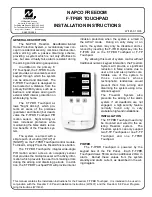
Copyright Bosch Solar Energy Corp., version 1.0
Page 7 of 19
3.
MODULE PERFORMANCE AND SAFETY STANDARDS
A.
Standard Test Conditions
The module electrical r a t i ng s a t Standard Test Conditions appear on the label on the back of
each module. Standard Test Conditions are defined as an irradiance level of 1000W/m
2
, AM 1.5
spectrum and a cell temperature of 25°C (77°F). It is important to note that, under normal
o p e r a t i n g conditions, a photovoltaic module is likely to experience conditions that produce
more current and/or voltage than reported at Standard Test Conditions.
B.
Underwriters Laboratories Information
These Bosch Solar Energy modules are listed to UL 1703, the Standard for Safety for Flat-Plate
Photovoltaic Modules and Panels. This Standard covers solar PV modules intended for
installation on or integral with buildings or to be freestanding (not attached to buildings), in
accordance with the National Electrical Code (NFPA 70), appropriate building codes, and any
other applicable local codes in the US.
C.
National Electrical Code (NEC)
The National Electrical Code (NEC) covers the installation of photovoltaic systems and must be
adhered to when systems are designed and installed. Article 690, Solar Photovoltaic Systems, of
the NEC applies to solar photovoltaic energy systems including the array circuit(s), power
conditioning unit(s) and controller(s) for such systems.
Under normal conditions, a photovoltaic module is likely to experience conditions that produce
more current and/or voltage than reported at Standard Test Conditions. As previously
mentioned, the values of Isc and Voc marked on the modules must be sized according to section
690-8 of the National Electrical Code. All wiring shall be in accordance with the NEC, and
grounding method of the module arrays shall comply with the NEC, Article 250.
4.
LOCATION OF SOLAR MODULES
A.
Orientation, Tilt Angle, Shading, & Performance
Photovoltaic modules generate maximum power when facing directly towards the sun. PV
systems can track the sun or remain in a fixed tilt position. Tracking systems will produce more
energy o n a n a n n u a l b a s i s but are more costly and m a y require more maintenance.
Most PV systems are designed with a fixed tilt. The further North from the equator, the greater
the tilt angle required. Since applications vary widely, be sure to consult a PV system integrator
or use a commercially available software program to determine the expected system energy
output. The following chart may serve as a rule of thumb.
Site Latitude Horizontal Tilt Angle
0-10
= 10 Degrees
11-20
= Latitude
21-30
= La 5~
31-40
= La 10~
41+
= La 15~





































